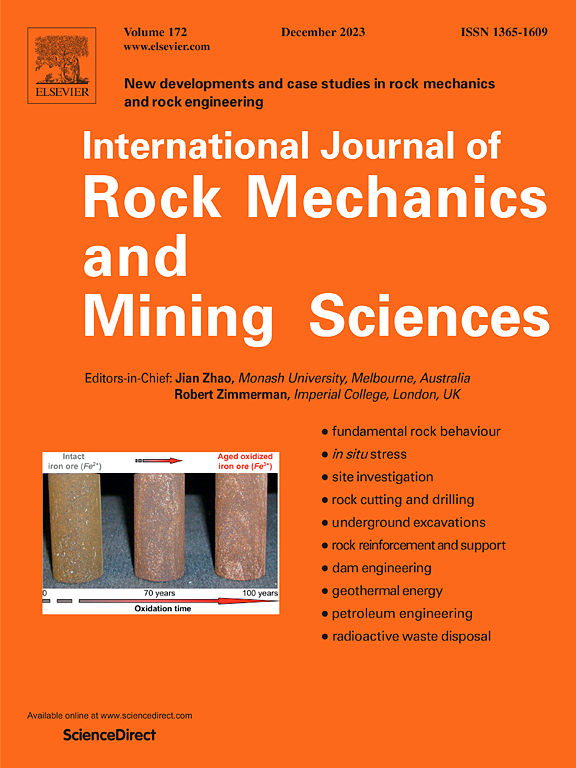Rock fragmentation of simulated transversely isotropic rocks under static expansive loadings
IF 7
1区 工程技术
Q1 ENGINEERING, GEOLOGICAL
International Journal of Rock Mechanics and Mining Sciences
Pub Date : 2024-11-01
DOI:10.1016/j.ijrmms.2024.105944
引用次数: 0
Abstract
Rock fragmentation is a critical process for mineral extraction and for mitigating overstressed rock in geotechnical applications. In this study, 3D-printed concrete was used to simulate the stratified rock mass, and experimental and numerical methods were employed to investigate crack propagation under static expansive loadings in transversely isotropic rocks. Two types of cracks were observed in the experiments: P-type (a crack propagates primarily along the weak layer) and T-type (a crack propagates across the weak layers) cracks. The findings revealed that the orientation of layers significantly influenced the initiation and propagation of cracks, with P-type cracks commonly observed in simpler P-P mode fragmentations and more complex P-P-T modes emerging under higher expansive loadings. P-T-T modes were characterized by the simultaneous presence of the T-type crack after an initial P-type crack. The AE energy levels in the P-P-T and P-T-T modes were much higher than those in the P-P mode. 2D-DDA models were further built to understand the effects of the loading scales, layer angles, and locations of weak layers on the cracking sequences. The results provided detailed insights into stress evolutions and the impact of expansive loadings on crack initiation and propagation.
在静态膨胀荷载作用下模拟横向各向同性岩石的碎裂情况
岩石破碎是矿物开采和缓解岩土工程应用中岩石应力过大的关键过程。本研究使用三维打印混凝土模拟分层岩体,并采用实验和数值方法研究横向各向同性岩石在静态膨胀荷载作用下的裂纹扩展。实验中观察到两种类型的裂缝:P 型裂缝(裂缝主要沿软弱层扩展)和 T 型裂缝(裂缝跨越软弱层扩展)。研究结果表明,岩层的走向对裂缝的产生和扩展有很大影响,P 型裂缝通常出现在较简单的 P-P 模式碎裂中,而在较高的膨胀荷载下,则会出现更复杂的 P-P-T 模式。P-T-T 模式的特点是在初始 P 型裂纹之后同时出现 T 型裂纹。P-P-T 和 P-T-T 模式的 AE 能级远高于 P-P 模式。我们进一步建立了二维-DDA 模型,以了解加载尺度、层角和薄弱层位置对开裂序列的影响。研究结果详细揭示了应力演变以及膨胀荷载对裂纹萌生和扩展的影响。
本文章由计算机程序翻译,如有差异,请以英文原文为准。
求助全文
约1分钟内获得全文
求助全文
来源期刊
CiteScore
14.00
自引率
5.60%
发文量
196
审稿时长
18 weeks
期刊介绍:
The International Journal of Rock Mechanics and Mining Sciences focuses on original research, new developments, site measurements, and case studies within the fields of rock mechanics and rock engineering. Serving as an international platform, it showcases high-quality papers addressing rock mechanics and the application of its principles and techniques in mining and civil engineering projects situated on or within rock masses. These projects encompass a wide range, including slopes, open-pit mines, quarries, shafts, tunnels, caverns, underground mines, metro systems, dams, hydro-electric stations, geothermal energy, petroleum engineering, and radioactive waste disposal. The journal welcomes submissions on various topics, with particular interest in theoretical advancements, analytical and numerical methods, rock testing, site investigation, and case studies.

 求助内容:
求助内容: 应助结果提醒方式:
应助结果提醒方式:


